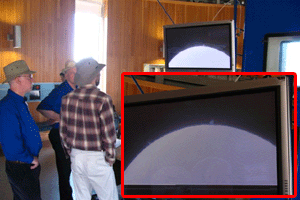 Live solar observing at Chabot Space & Science CenterWhile NASA may have just started showing us the Sun "as never before seen" through their Solar Dynamics Observatory (yes, with each new launch of a solar satellite, we again see the Sun as never before seen—which is actually very cool), at Chabot our observatory volunteers have started doing the same thing--in your own backyard!
Live solar observing at Chabot Space & Science CenterWhile NASA may have just started showing us the Sun "as never before seen" through their Solar Dynamics Observatory (yes, with each new launch of a solar satellite, we again see the Sun as never before seen—which is actually very cool), at Chabot our observatory volunteers have started doing the same thing--in your own backyard!
Our weekend daytime observatory volunteer team has assembled their own live solar observatory, using a SolarMax 70 hydrogen-alpha filter telescope, a video camera, a wireless transmitter, and a large flat-panel display screen—and now that the weather is beginning to cooperate, their offering to our visitors will take place on a more regular basis.
I was up there last Sunday to see the system at work, and was very impressed. With the telescope and wireless transmitter set up outside on the observatory deck, the image of the Sun captured by the video camera was transmitted into the dome of our large telescope, Rachel, where a receiver caught the signal and piped it into the large display monitor attached to the central pier.
Even though there were no sunspots that day—and sunspots are what people generally expect to see, if anything—the Sun put on quite a show in the "hydrogen alpha" wavelength of light (a select red color emitted by hot hydrogen in the Sun's atmosphere). While the Sun's visible surface is populated by features like granules (convection cells), sunspots, and faculae, the h-alpha scope revealed a layer of the Sun's atmosphere, the chromosphere ("sphere of color", named for the bright red light emitted by the hydrogen gas).
We observed several filaments and two or three prominences on this day, even though the Sun was relatively quiet and showing little surface sunspot activity.
